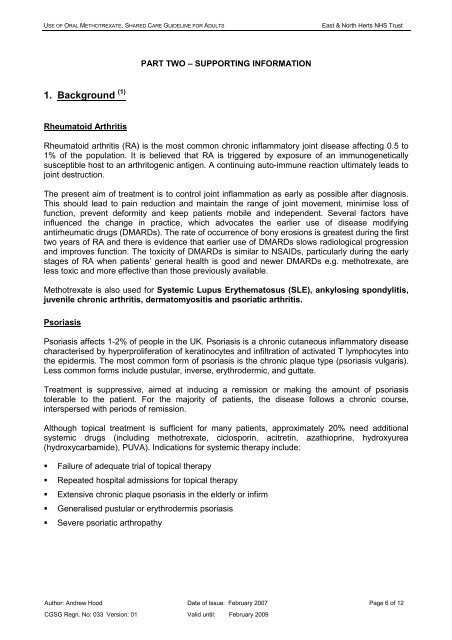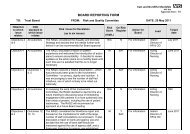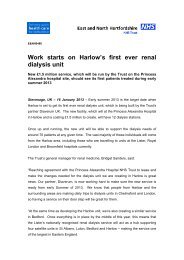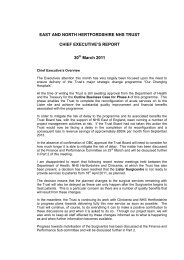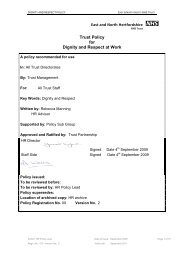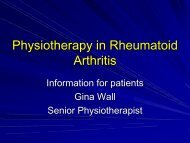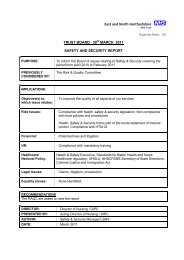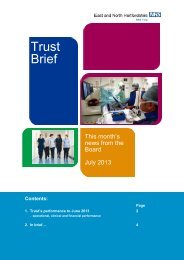Use of Oral Methotrexate, Shared Care Guideline for Adults
Use of Oral Methotrexate, Shared Care Guideline for Adults
Use of Oral Methotrexate, Shared Care Guideline for Adults
Create successful ePaper yourself
Turn your PDF publications into a flip-book with our unique Google optimized e-Paper software.
USE OF ORAL METHOTREXATE, SHARED CARE GUIDELINE FOR ADULTS<br />
East & North Herts NHS Trust<br />
PART TWO – SUPPORTING INFORMATION<br />
1. Background (1)<br />
Rheumatoid Arthritis<br />
Rheumatoid arthritis (RA) is the most common chronic inflammatory joint disease affecting 0.5 to<br />
1% <strong>of</strong> the population. It is believed that RA is triggered by exposure <strong>of</strong> an immunogenetically<br />
susceptible host to an arthritogenic antigen. A continuing auto-immune reaction ultimately leads to<br />
joint destruction.<br />
The present aim <strong>of</strong> treatment is to control joint inflammation as early as possible after diagnosis.<br />
This should lead to pain reduction and maintain the range <strong>of</strong> joint movement, minimise loss <strong>of</strong><br />
function, prevent de<strong>for</strong>mity and keep patients mobile and independent. Several factors have<br />
influenced the change in practice, which advocates the earlier use <strong>of</strong> disease modifying<br />
antirheumatic drugs (DMARDs). The rate <strong>of</strong> occurrence <strong>of</strong> bony erosions is greatest during the first<br />
two years <strong>of</strong> RA and there is evidence that earlier use <strong>of</strong> DMARDs slows radiological progression<br />
and improves function. The toxicity <strong>of</strong> DMARDs is similar to NSAIDs, particularly during the early<br />
stages <strong>of</strong> RA when patients’ general health is good and newer DMARDs e.g. methotrexate, are<br />
less toxic and more effective than those previously available.<br />
<strong>Methotrexate</strong> is also used <strong>for</strong> Systemic Lupus Erythematosus (SLE), ankylosing spondylitis,<br />
juvenile chronic arthritis, dermatomyositis and psoriatic arthritis.<br />
Psoriasis<br />
Psoriasis affects 1-2% <strong>of</strong> people in the UK. Psoriasis is a chronic cutaneous inflammatory disease<br />
characterised by hyperproliferation <strong>of</strong> keratinocytes and infiltration <strong>of</strong> activated T lymphocytes into<br />
the epidermis. The most common <strong>for</strong>m <strong>of</strong> psoriasis is the chronic plaque type (psoriasis vulgaris).<br />
Less common <strong>for</strong>ms include pustular, inverse, erythrodermic, and guttate.<br />
Treatment is suppressive, aimed at inducing a remission or making the amount <strong>of</strong> psoriasis<br />
tolerable to the patient. For the majority <strong>of</strong> patients, the disease follows a chronic course,<br />
interspersed with periods <strong>of</strong> remission.<br />
Although topical treatment is sufficient <strong>for</strong> many patients, approximately 20% need additional<br />
systemic drugs (including methotrexate, ciclosporin, acitretin, azathioprine, hydroxyurea<br />
(hydroxycarbamide), PUVA). Indications <strong>for</strong> systemic therapy include:<br />
<br />
<br />
<br />
<br />
<br />
Failure <strong>of</strong> adequate trial <strong>of</strong> topical therapy<br />
Repeated hospital admissions <strong>for</strong> topical therapy<br />
Extensive chronic plaque psoriasis in the elderly or infirm<br />
Generalised pustular or erythrodermis psoriasis<br />
Severe psoriatic arthropathy<br />
Author: Andrew Hood Date <strong>of</strong> Issue: February 2007 Page 6 <strong>of</strong> 12<br />
CGSG Regn. No: 033 Version: 01 Valid until: February 2009


